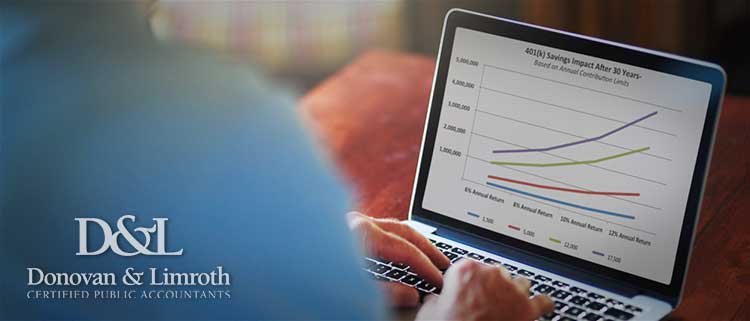
The answer to this question is individual. Before making a decision, closely examine your financial situation.
A trusted advisor or accountant, such as Donovan & Limroth, can help guide you and analyze the short-term and long-term impact of your options. When considering an IRA, here is an overview to get you ready for these conversations and, ultimately, decisions.
IRA DO’S
- Open an IRA as soon as you qualify. This gets you started as early as possible, saving and growing for your retirement.
- Contribute more early on. Opening your IRA is the first step. The more you contribute early on, the longer time period it has to grow. Postponing contributions now will leave you short later.
- Understand the difference between a traditional and Roth IRA. Wages earned and contributed to a Traditional IRA are not taxable at the time they are deposited. When distributions or withdrawals are made, however, these amounts are then taxed. A Roth IRA works the opposite. No tax relief is received at the time of contribution. Instead, a Roth IRA provides for tax relief upon the distribution of funds.
- Aim to save 15% of pre-tax income each year. This is a good rule of thumb. The percentage should vary depending upon the age you begin saving, age you want to retire and your income. You can use a retirement calculator to help you determine your exact percentage.
IRA DON’TS
- Choose a Traditional IRA for immediate tax relief. Is deferring taxes on a smaller amount contributed today and paying taxes later on a greater amount after your investment has grown the best choice for you? Possibly, because you will be in a lower tax bracket at retirement, but be sure to consider all these things when making your investment decisions.
- Not opening an IRA because you have a 401(k). If your employer offers a 401K and matches your contributions, contribute the maximum that your employer will match. If you are saving at a rate of 15% and the maximum contribution does not meet your 15% goal, then contribute the remainder to an IRA or Roth IRA
- Cash out your 401(k) when you leave a job. Doing so causes you to pay Federal Income Tax on the distribution and an early distribution penalty of 10%. Instead, roll the amount over into your IRA or Roth IRA. It will add up and keep those dollars growing for retirement.
- Use your Roth IRA before retirement if not necessary. The contribution amounts to a Roth IRA can be withdrawn tax and penalty-free at any time for any reason (this is not the case with a traditional IRA or 401(k)). This may create a temptation when you go to buy a house or want to help put your child through college. Think twice!
Do you feel ready to talk about your retirement savings? You can also review the top picks for 2017 of the Best IRA Accounts and the Best Roth IRA Accounts. If you have questions about retirement planning and IRA or Roth IRA account providers, contact Donovan & Limroth, and we will be happy to assist you.


